Neurodiversity, a concept that advocates for the acceptance and celebration of a range of neurological differences, is becoming central to modern education. This approach views neurological variations—such as dyslexia, ADHD, and autism—not as disorders but as natural aspects of the human experience. Embracing neurodiversity helps create a more inclusive classroom environment where all students can thrive.
What is Neurodiversity?
The concept of neurodiversity suggests that neurological differences, including dyslexia, ADHD, and autism, are natural variations within the human experience. This perspective moves away from viewing these conditions as medical problems and instead encourages acceptance of them as an integral part of human diversity. Neurodiversity promotes a shift in focus from deficits to recognising the unique abilities and perspectives individuals with different neurological profiles bring to society.
Neurodiversity in Children
Neurodiversity in children manifests as a range of differences that can affect behaviour, learning, and interaction. These variations may influence a child’s ability to manage everyday tasks, understand information, and engage in social settings. Common conditions under the neurodiversity umbrella include:
- Autism Spectrum Disorder (ASD): Characterised by differences in communication, behaviour, and social interaction.
- Attention Deficit Hyperactivity Disorder (ADHD): Marked by difficulties with attention, hyperactivity, and impulsiveness.
- Dyslexia: A learning difference that affects reading and language processing.
By understanding and supporting children according to their individual needs and strengths, educators and parents can create a fairer and more effective learning environment.
Types of Neurodiversity
Neurodiversity encompasses various conditions, each with distinct characteristics and challenges. Key types include:
- Autism Spectrum Disorder (ASD): A developmental condition that impacts communication, behaviour, and social interaction.
- Attention Deficit Hyperactivity Disorder (ADHD): Identified by persistent patterns of inattention, hyperactivity, or impulsivity.
- Dyslexia: Impairs language processing and affects reading comprehension.
- Dyspraxia: Involves difficulties with motor planning and coordination.
- Sensory Processing Disorder (SPD): Affects how the brain processes sensory information, influencing reactions to stimuli.
Neurodiversity in Schools
Integrating neurodiversity into education involves recognising and accommodating the diverse neurological needs of students. This can be achieved through:
- Inclusive Teaching Practices: Adopting teaching methods that accommodate various learning needs and styles.
- Differentiated Instruction: Tailoring teaching strategies to meet each student’s specific requirements.
- Support Services: Providing access to specialised support, such as speech therapy, occupational therapy, and counselling.
Programs for Neurodiversity
School-based neurodiversity programs aim to support students with different neurological profiles. These initiatives may include:
- Individualised Education Plans (IEPs): Customised plans that outline specific learning goals and support services for students.
- Training for Teachers: Professional development courses that equip educators with the skills needed to support neurodiverse students effectively.
- Peer Support Initiatives: Activities like buddy systems and awareness workshops that promote inclusivity and understanding among students.
These programs aim to create a supportive and adaptable learning environment, providing every student with the opportunity to succeed.
The Neurodiversity Symbol
The neurodiversity symbol, often depicted as a colourful infinity loop, represents the acceptance and celebration of neurological differences. It symbolises a society that values and embraces people with diverse neurological profiles, recognising neurodiversity as a vital aspect of human diversity.
Conclusion
Understanding neurodiversity is essential for creating an inclusive and supportive educational environment. By acknowledging and valuing the diverse neurological profiles of their students, educators can implement strategies and programs that enhance learning and development for all, ensuring that every child has the opportunity to thrive.









